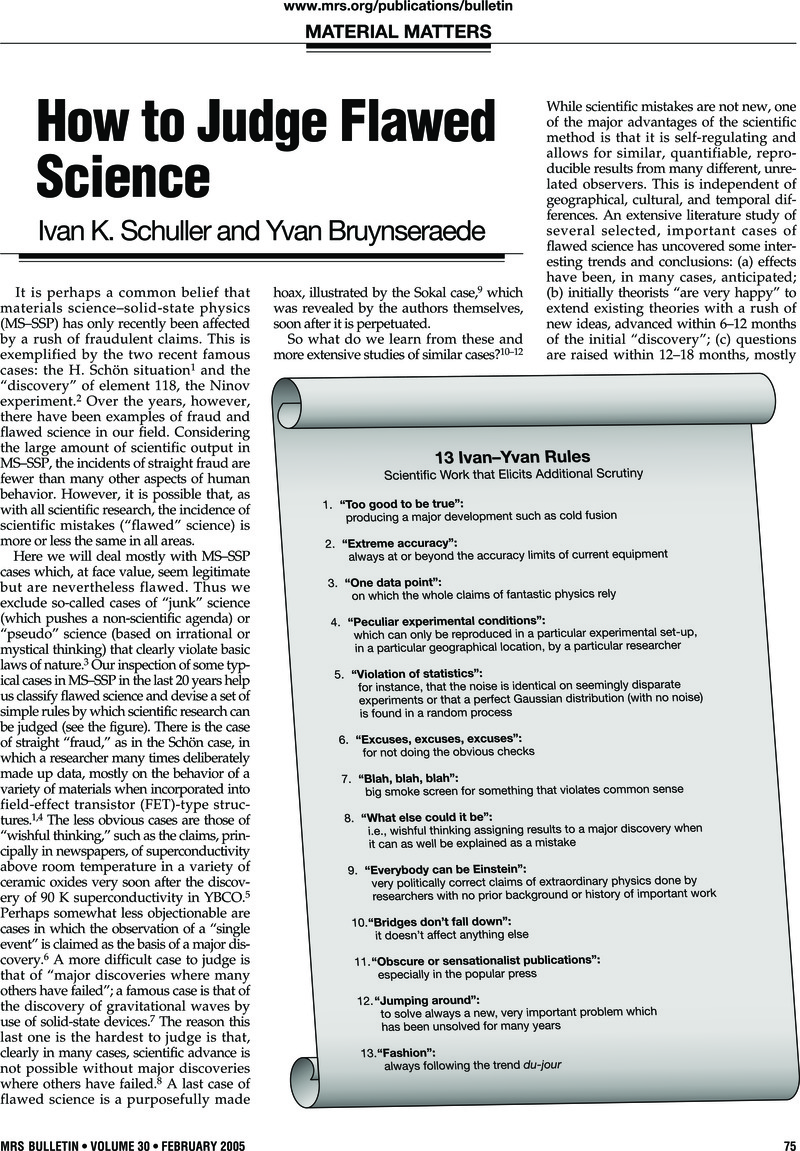No CrossRef data available.
Article contents
How to Judge Flawed Science
Published online by Cambridge University Press: 31 January 2011
Abstract
An abstract is not available for this content so a preview has been provided. As you have access to this content, a full PDF is available via the ‘Save PDF’ action button.

- Type
- Material Matters
- Information
- Copyright
- Copyright © Materials Research Society 2005
References
1. For the original Schön, H. report, see www.lucent.com/news_events/pdf/researchreview. pdf (accessed December 2004).Google Scholar
2. For a discussion of the Ninov affair, see Muir, H., “Elementary mistakes due to falsified data,” www.newscientist.com/news/print. jsp?id=ns99992545 (accessed December 2004), and links mentioned therein.Google Scholar
3.Park, R.L., Voodoo Science: The Road from Foolishness to Fraud (Oxford University Press, Oxford, UK, 2000); N.J. Turro, “Toward a general theory of pathological science,” www.columbia.edu/cu/21stC/issue-3.4/turro.html (accessed December 2004); and H.H. Bauer, “‘Pathological Science’ is not Scientific Misconduct (nor is it pathological),” www.hyle.org/journal/issues/8–1/bauer.htm (accessed December 2004).Google Scholar
4. For a discussion and further links to the Schön, H. affair, see Lerner, E., “Fraud Shows Peer-Review Flaws,” www.aip.org/tip/INPHFA/vol-8/iss-6/p12.html (accessed December 2004); I.K. Schuller and G.G. Güntherodt, “Fraud: The System Works,” Nature 418 (2002) p. 817; and C.A. Murray and S.R. Das, “The Price for Scientific Freedom,” Nature Mater. 2 (2003) p. 204.Google Scholar
5. As an example, see “Superconductivity Breaks Room-Temperature Barrier,” Business Week, June 20, 1987.Google Scholar
6.Taubes, G., Bad Science: The Short Life and Weird Times of Cold Fusion, 1st ed. (Random House, New York, 1993).Google Scholar
7.Weber, J., “Detection and Generation of Gravitational Waves,” Phys. Rev. 117 (1960) p. 306.CrossRefGoogle Scholar
8. For a cautionary discussion, see Josephson, B.D., “Pathological Disbelief,” www.lindau-nobel.de/images/ock/media/downloads/Media_1703187544.htm (accessed December 2004).Google Scholar
9. For the original article, see Sokal, A., “Transgressing the Boundaries: Toward a Transformative Hermeneutics of Quantum Gravity,” Social Text 46/47 (Spring/Summer 1996) p. 217.Google Scholar
10. See, for instance, Langmuir, I., “Pathological Science,” Phys. Today 42 (October 1989) p. 36 and available at www.cs.princeton.edu/∼ken/Langmuir/langmuir.htm (accessed December 2004).CrossRefGoogle Scholar
11.Shermer, M., Why People Believe Weird Things: Pseudoscience, Superstition, and Other Confusions of Our Time, (Owl Books, New York, 2002).Google Scholar
12.Magyar, G., “Pseudo-Effects in Experimental Physics—Some Notes for Case-Studies,” Social Stud. Sci. 7 (1977) p. 241.CrossRefGoogle Scholar
13.Kantor, W., “Direct First-Order Experiment on the Light Propagation from a Moving Source,” J. Opt. Soc. Am. 52 (1962) p. 978.Google Scholar
14.Dontsov, Yu.P. and Baz, A.I., “Interference Experiments with Statistically Independent Photons,” Sov. Phys. JETP 25 (1967) p. 1.Google Scholar
15.Kepros, J.G., Eyring, E.M., and Cagle, F.W. Jr., “Experimental Evidence for an X-Ray Laser,” Proc. Natl. Acad. Sci. USA 69 (1972) p. 1744.CrossRefGoogle ScholarPubMed
16.Schwartz, H. and Hora, H., “Modulation of an Electron Wave by a Light Wave,” Appl. Phys. Lett. 15 (1969) p. 349.Google Scholar




